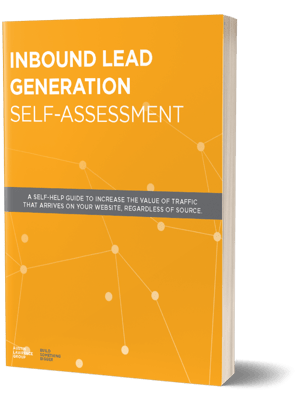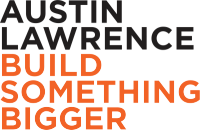A CMO’s problems are fundamentally different than they were a year ago. And that's even more true if you're new in the job. Increasing sales in the short term requires content that jump-starts prospect engagement. Easier said than done, especially in a pandemic and when everyone’s inbox is flooded daily with crap.
To help your sales team get more engagement, content must hit prospects squarely with topics that speak directly to the problems they’re trying to solve. Now. And every piece needs to advance the sale in some way.
Put another way, marketing content should help identify buyers with intent (inbound) and sales should provide the personalization, context and relevance to each prospect they touch (outbound).
I'm not ready for a demo.
One of the most common mistakes I find when reviewing websites for lead generation potential is that after arriving at the website and reading a well-written and informative blog, there’s nowhere for the reader to go.
Too many sites cut directly to “schedule a meeting.”
I’m not interested…yet.
Or “request a demo.”
But I’m not ready for a demo, and I don’t want to talk to a salesperson... yet.
When someone is reading a business blog, it’s usually because they’re trying to solve a problem, and that’s why they started researching in the first place.
So, if there aren’t options that lead them to the next logical piece of content, they bounce—forever lost to the sands of time, and a website that’s better tuned to their pain points and with better calls-to-action to make them a lead for a competitor.
Every bounce from an otherwise qualified prospect is a missed opportunity for sales to gain potential lead intelligence.
Everyone involved in customer acquisition needs to think about the customer experience and what they're trying to do when they read a blog and visit your website. That means thinking about the next piece of content that we can present or send them to educate them further, stewarding them down a path to sales-readiness.
Think about what content will help them move from “I have a problem,” to “I’m interested in your solution, and I want to talk to you.”
To get this right, B2B content marketers need several key elements in place.
Here's how to build the foundational lead generation content you need, in the most efficient way possible:
Step 1. Collaborate with Sales (and anyone else who’s customer facing).
If marketing has never had to pick up the phone and talk to prospects or customers, the next best thing is to interview salespeople, business development representatives (BDRs), and customer success about their experiences with prospects and customers.
Make sure you’re digging for the true reasons that people buy from you.
It’s important for marketing to hear these issues and objections on a regular basis so that they can develop content that will get engagement and answer objections.
Watch how your BDRs are prospecting—what emails are they sending out? What content do they use regularly? How are they using email and social media? Which sequences get the most engagement?
Sit in on sales calls (if you can) so you can hear these issues from the horse’s mouth. Find the buying trigger events. Your salespeople should have some ideas here—what are the triggers they use to identify a prospect?
Talk about what customers and prospects have been bringing up in their sales calls—why did they reach out? What in your outreach got their attention?
Step 2. Brainstorm typical prospect pain points.
“It’s not about you” has been hammered into marketing’s collective psyche, and that sentiment is crucial if you plan to get engagement.
So now that you’ve conducted interviews, it’s time to brainstorm every pain point that you can think of on a white board or shared Google Doc.
If you’ve had some inbound leads in the past that have become customers, research the path they took to get there. How many pieces did they consume before taking a call? What did they download? How did they find it in the first place?
This is not a one-time activity.
Put together a project team that meets regularly, consisting of all the stakeholders, and revisit your buyer personas and the problems they must solve.
Step 3. Determine the top three overarching pain points.
When you look at your brainstorm, you’ll see some common themes emerge that should be based around a specific buying trigger.
Choose three of these as overarching pain points and group the other pains as facets underneath.
For example, we know that a when a company hires a new CMO, it’s usually not because everything was running smoothly before. And the new hire is usually up to their neck in alligators from the moment they step into the job.
So, we developed a lead magnet to help them plan out their first one hundred days on the job (see it here). When someone downloads it, we have a good idea about what their problem is, so from an inbound perspective, we can develop a workflow to send more helpful content around the issues of being a new CMO.
In our sales process, we research B2B marketing leaders who have changed jobs in the past 90 days on LinkedIn and if they fit our target buyer persona, we send them our first hundred days document as a way to introduce ourselves and be helpful at the same time.
Step 4. Determine the top-of-funnel topics.
 |
|
Free Download: Increase the value of your website's traffic with our Inbound Lead Generation Self-Assessment. |
Underneath each of the overarching pain points, list the relevant topics that you can develop into content. In our example of the overarching pain point of being a new CMO, here are some of our ideas:
- Stepping into a “mess” and how to get a sense of the organizational politics and eliminating toxicity
- How to fix a stalled pipeline with lead generation and find quick wins
- Fixing churn as a priority
- Getting aligned with the CEO’s vision
- How to quickly gain trust in organization
- Evaluating agency relationships and inherited team skillsets
You can see how all of these topics could be of interest to a new CMO, so the idea is that we’re going to regularly develop content on these topics and in every one of them, we’re going to push them to the lead magnet.
Step 5. Develop the content in tandem with the key lead magnet.
Now you need to develop the outlines for your lead magnets and blog posts and figure out how they’re going to get developed.
- Who are your subject matter experts?
- What types of content can you develop? (videos, blogs, webinars, interviews?)
- What questions do you need to ask your subject matter experts to ensure that you’re getting to the real issues and answers?
For example, to develop our white paper on the first 100-day plan for new heads of marketing, we interviewed several CMOs that had recently transitioned a marketing organization. And we asked a few of them to review and add their ideas to the document (which they did, and that made the document even more valuable to other CMOs).
One of the CMOs who helped with the first hundred days eBook was a recent guest on our podcast and talked a lot about how to be successful as a new CMO.
Develop questions for subject matter experts to provide the meat. And if possible, conduct the interviews on camera so you have video that can be used in the article and posted as bite-size clips on social media. This is a way to get the most content for the least amount of effort on the part of your SMEs, and I can assure you, they will appreciate it.
Step 6. Determine your distribution strategy.
Now that you’ve got at least one good lead magnet and a blog or two to push to it, how are you going to make sure the right people see it?
Your email lists are the best place to start. Best practice now is to write a few paragraphs about why this particular article is important and tell a story about its development.
Check out this email promoting one on our recent SaaS Backwards podcast episodes.
LinkedIn profiles for your executives and company are really a mandatory place to promote content. Make sure to write pithy and short posts. Even better is to record short, less than one-minute promo videos to help drive traffic to the content. We use subtitles on all videos we create as most people don’t use sound at work (though with WFH being so widespread, more people may choose to have sound on in their home offices).
Many B2B marketers are finding success on Facebook and Instagram, and if you haven’t already, you should experiment with these social media properties, too.
Once you’ve exhausted “free” ways to disseminate your content, you can start to experiment with paid promotions on your social channels and search ads on Google. If you have a marketing automation system like HubSpot it will be relatively easy to place ads and track which channels are driving the most valuable engagement with your content assets.
Step 7. Provide Sales with playbooks and email sequences.
Beyond marketing email and advertising, the second fastest way to get the content in front of prospects is for your salespeople to use it in their outreach.
They most likely won’t intuitively know how to do this, so you have to provide some ways they can do just that by developing a sales playbook.
Your playbook can provide the strategy behind the outreach:
- Who’s the intended target?
- What do we hope they’ll do with the information?
- What else in our content library can they use to push prospects to the key lead magnet?
- What was the buying trigger?
- How does our solution help?
All of those are important for the salesperson to figure out who in their target list should get this, and why now.
If your team is struggling with response rates to their email sequences, you might offer to help write them and see if they outperform the old standbys. We’ve found that taking a copywriting approach to the sales sequence can help cut through the clutter of today’s inbox.
The days when you could send a simple BASHO email, or the threaded “predictable revenue” type email sequences might just about be over. So, ask your best copywriter to take a look and do a true creative process against the sales email sequence that’s most in need of improvement (strategic value, poor performance, etc.). Then measure and repeat.
Short term vs. long term strategies
When your sales team is struggling for inbound leads, it’s marketing’s priority to help.
That doesn’t mean, however, that you have to abandon thought leadership content for short-term pipeline building.
Think about it this way—the lead magnets you’ve developed from your overarching pain points probably aren’t going to change. They’re evergreen, and more middle of the funnel. They have problem awareness and you’re moving them toward solution awareness, which is why a conversion provides lead intelligence.
Every blog post, webinar, and interview with a subject matter expert can be developed into thought leadership. That’s the content that helps prospects with problem awareness; they didn’t know they had that problem until they read that article. Or, they knew they had a problem but were unaware of how to solve it.
When you organize your content strategy this way, everything you’re producing is assisting the sales process. And content production becomes much more efficient—that one podcast interview can be turned into several blog posts. So too, can that recent webinar.
And the best news is that salespeople will love you for it. No more complaining about how leads aren’t qualified—because they were involved from the beginning in the content creation that generated the leads.
They know why it was developed, and how to use it to get doors opened for more conversations.
Want to talk more about content development for lead generation? Call me at 646.998.4835 or email jm@austinlawrence.com, or book a quick discovery call here.






